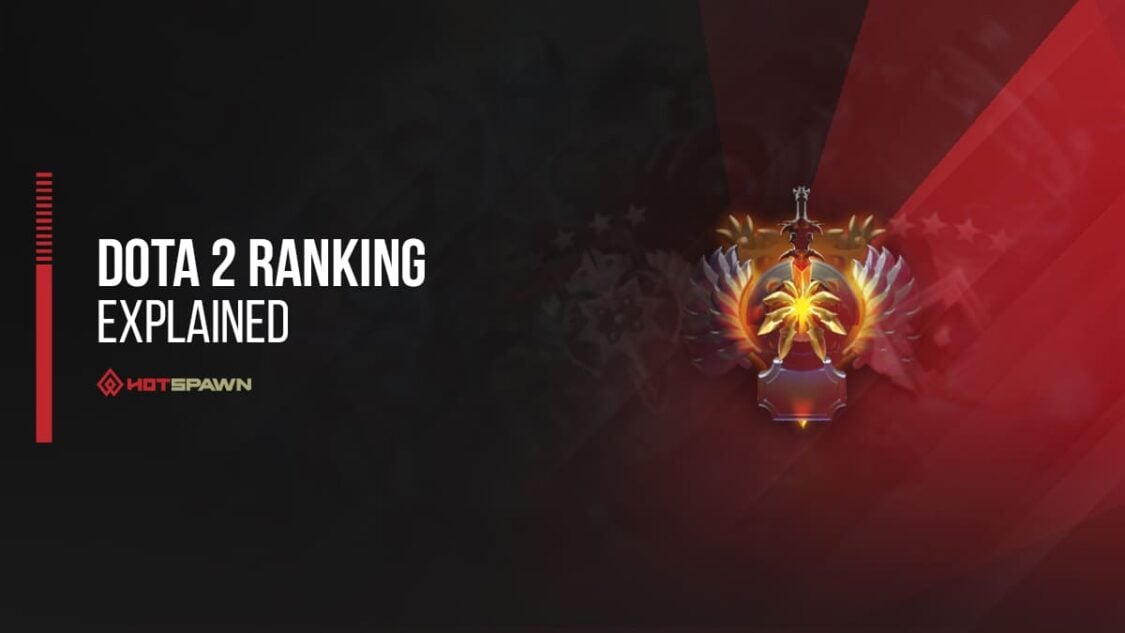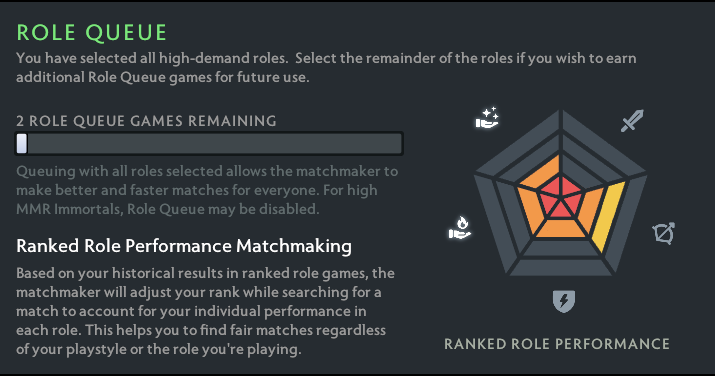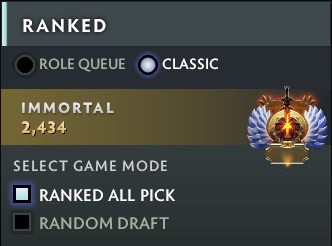Being one of the most competitive titles in the world, Dota 2’s ranked matchmaking system is an ultimate test of skill, strategy, and teamwork. All players will be assigned a Matchmaking Rating (MMR) and a medal to reflect it after playing ranked games, which determines their rank and skill level. It measures their proficiency, decision-making, and overall game sense.

The ranking system is primarily used to ensure fair competition, as players of similar skill levels are matched against each other, creating balanced and challenging matches. If you’re looking to tread the path to higher ranks, it is crucial to understand how the MMR system works. In this guide, we’ll break down all Dota 2 ranks and explain the intricacies of matchmaking.
Dota 2’s ranked matchmaking is a competitive game mode where players are matched based on their Matchmaking Rating, or MMR. The system serves as a measure of individual skill and progression, allowing players to track their improvement over time.
Each win or loss in a ranked match will directly impact MMR, determining the player’s rank and medal. Climbing up the ranks will force players to encounter more formidable opponents, and players who don’t belong will be sent down to the ladder until they improve.
The Dota 2 ranking system is built around MMR, a numerical value that assesses a player’s skill level. Of course, this means the best Dota players in the world have some truly staggering MMR numbers.
The MMR value is always visible to players, allowing them to frequently check their current ratings and track progression.

Winning a match increases a player’s MMR, moving the player closer to a higher rank, while losing a match decreases MMR, leading to a potential drop in rank.
Players are assigned to a ranked medal based on their current MMR. This ranking system is divided into eight main ranks.
The eight medals in the game in ascending order are:
Ranks from Heald to Divine are divided into five subdivisions, represented as Roman numerals in ascending order. These divisions help refine matchmaking by ensuring players face opponents of similar skill levels within their respective medals.

Players must progress through subdivisions within a medal to reach a new one. For example, a player at Legend III must advance to Legend IV and V before finally progressing to the successive medal, Ancient, where they will land on Ancient I to begin with.
Unlike other ranks, Immortal doesn’t have subdivisions. Instead, Immortal-ranked players are categorized into a leaderboard system that updates in real-time.
Medals are publicly visible on player profiles and will update automatically if a player reaches a higher rank or is forced to de-rank to a lower one.
As covered earlier, the Dota 2 ranking system is structured into eight primary ranks, representing a different skill level and understanding of the game. As we go higher in rank, players become increasingly capable. Here is a breakdown of what to expect from players in each bracket.
Herald is the lowest rank in the game. Most players in this bracket are new to the game and have difficulty adjusting to Dota 2’s steep learning curve. Dota beginners in this rank lack a basic understanding of the game and find maximizing the game’s mechanics challenging.
Guardian is a step above Herald, though the difference isn’t too drastic. Players from 770 to 1,540 MMR have a slightly better understanding of their heroes and roles. They begin to grasp itemization and see marginal improvements in map awareness.
Things escalate in Crusader, where the majority of players in this rank begin to display noticeable improvements. Last-hitting and farming creeps in Dota will improve significantly, but players still fail to recognize hero power spikes and optimal rotations.
Archon is where the median of the player base resides. Archon players begin developing a deeper understanding of Dota 2 and its mechanics. Players are more efficient and prioritize objectives. The vision game from supports also improves drastically.
The best way to describe players in Legend is by calling them “solid”. Players demonstrate a good grasp of the game’s fundamentals, and most begin to specialize in particular roles and choose the best Dota heroes for their playstyle. Positioning in team fights improves, and most players begin communicating effectively.
Ancient is the tier where players start becoming good at the game. Many in this rank emphasize drafting and counter-picking since Ancient players have a steeper understanding of heroes and matchups. Games are more structured and strategic, and players have developed mechanical skills.
Divine is the gateway to the highest level of Dota 2. Players in this rank are skilled and experienced, easily displaying highly refined mechanics and decision-making. You will see mechanically demanding heroes being picked often in Divine matches.
The Immortal rank is the pinnacle of Dota 2, where the cream of the crop compete. Players in this rank display near-flawless mechanical execution and game sense. The laning stage, rotations, and resource management is top-notch, and teams function with precise coordination.
However, reaching the Immortal rank doesn’t instantly make you a semi-pro, let alone a professional player. You’ll have to at least rank on the leaderboards, first.
Achieving the Immortal medal is like reaching the top of a mountain. However, there’s a sky above the mountain. Players in Immortal can continue gaining MMR until they eventually reach the top 5,000 players in their region.
Qualified players will be sorted into the Regional Leaderboard, which ranks the best players based on their MMR. Leaderboard ranks are updated every hour, meaning ranks can change frequently depending on MMR gains and losses.

The lowest leaderboard rank displayed on a profile is rank 5,000. Then, placements go all the way down to rank 1.
The Immortal Leaderboard supports four primary regions: the Americas, Europe, China, and Southeast Asia.
There are additional details about how the Dota 2 ranked system works, so here are some intricacies to remember when going on your adventure.
Dota 2 ranked matches are generally based on a 25 MMR gain or loss per match. Though this is the most common numerical MMR change, players might receive varying amounts per match.
This change depends on the average MMR of both teams. If a team with a lower average MMR wins, they are likely to receive more than 25 MMR for the victory.
However, what remains constant is that the MMR change is always equal for both teams. This means that if a player gains 27 MMR from a win, every player on the winning team will receive the same amount, and every player on the enemy will also lose the exact same amount.
In a typical scenario, no player will win or lose more MMR than their teammates after a rank change.
There are three types of queues to get into a ranked match. Let’s uncover the different types.
Role Queue is the most popular queue type in ranked matchmaking. Before searching for a game, players can select their preferred roles. Once loaded into the game, each player on the team will be assigned a role based on their selected choices and must play that specific role.

However, queuing for a Role Queue match consumes a Role Queue token. Earning Role Queue tokens can be done by queuing for demanded roles, mainly the two support roles.
Role Queue matches lead to structured team balance and better hero compositions since players are in comfortable roles.
In the old days, players on the same team had to coordinate roles and heroes by default. Though we have ranked roles, the classic method of ranked matchmaking, called Classic Ranked, is still readily available. This means there are no role restrictions, and players can discuss hero picks manually. However, a team’s lack of set roles can sometimes lead to role conflicts, as players might fight over the same role.

Playing Classic Ranked is not recommended, as Role Queue is always the better option for higher-quality matches.
The Immortal Draft system is exclusively designed for players in the Immortal rank and is forced into matches from 6,500 MMR average onwards.
The two players with the highest MMR in the lobby will be assigned as team captains. They will take turns selecting players to be on their team from the other players in the game. Players to be picked can display their preferred side and comfortable roles.
However, the Immortal Draft system creates several problems, notably that players in a party can be assigned to different teams.
Aside from matching players based on raw MMR, there are several other factors used to balance the match quality of a ranked game.
Role Queue matchmaking is the most popular system among players. However, it might be difficult to find five players queueing for different roles during suboptimal queuing hours. The game might be forced to place a higher or lower-ranked player into a game to meet the criteria.
Players can queue for ranked matches with party members, and most of the time, players in a party could be of different ranks. As a result, matches can have MMR discrepancies, but the game will still try to match teams with a very similar average MMR.
Sometimes, players are placed into games with an extreme MMR imbalance. Though these cases are rare in average ranks, the game will automatically adjust the gain or loss.
Aside from MMR and medals, players are also assigned a behavior score, which measures a player’s conduct in matches. Behavior score is based on commendations, reports, abandons, and chat interactions.

Players with a high behavior score will be placed in teams who also average high behavior scores, leading to better matchmaking quality. Meanwhile, players with a low behavior score will get dumped into a team with similar players.
Though Valve has never made an official announcement, the community can attest to the existence of a “smurf pool,” a hidden system that detects smurf accounts to prevent high-ranked players from disrupting lower-ranked matches.
The game can automatically identify smurf accounts if it boasts unusual win rates, unnatural rank climbing, and insane statistics. If an account is flagged as a suspected smurf, it will be placed into the smurf pool. Accounts in the smurf pool will be matched against other flagged accounts.
However, accounts in the smurf pool could receive additional MMR per win, as Valve intends to propel these accounts to their deserved ranks as quickly as possible, leading to less low-ranked games being ruined.

The ultimate goal for all players grinding ranked matches is to eventually have their efforts paid off, and that’s by climbing up the ranking ladder. Here are some of the best tips to rank up quickly in Dota 2.
A team consists of players filling five different roles. With how complex Dota 2 is, it is tough to master all five roles. To climb the ranking system, it is better to focus on a single role rather than trying to become a jack of all trades.
Try playing all five roles and see which one fits your playstyle and personality. I highly recommend playing a maximum of two, though one is highly preferred.
Every once in a while, the Valve team releases a new Dota 2 balance patch. In these patches, some heroes are buffed, while others are nerfed. Some heroes will always be more potent than others in patches, so taking advantage of strong meta heroes is a great idea to gain an easy advantage.
Look at the heroes professional players are spamming, and check out free resources like Dota2ProTracker to figure out which are the best Dota heroes in the current patch.
Dota 2 isn’t a game where you aimlessly run around and kill heroes. It is an objective-based game where you must destroy the enemy team’s Ancient to win.
To accomplish this goal, you must take Dota map objectives such as towers, barracks, and Roshan. Plan out ganks where you can take an objective after winning a fight. Control key areas of the map instead of chasing for unnecessary kills.
Playing and watching Dota 2 is entirely different. You might be too locked in when playing to realize any mistakes, but you’ll be surprised to see how many errors you make throughout your game when rewatching a replay.
Download your own replays and take notes of the things you’re doing incorrectly. You can also learn a thing or two from reviewing replays of professional players.
Remember to keep a positive mental attitude (PMA). Flaming your teammates and creating tension between the team is a great way to lose a game. There is no point in making more enemies than the five you are already facing.
If you’re unhappy with how your teammates are playing, at least keep it to yourself. Feel free to suggest how they should fix their playstyle, but try not to instigate an argument.

And stay up to date on all the latest trends in esports
By submitting your information you agree to the Privacy Policy and Terms of Use